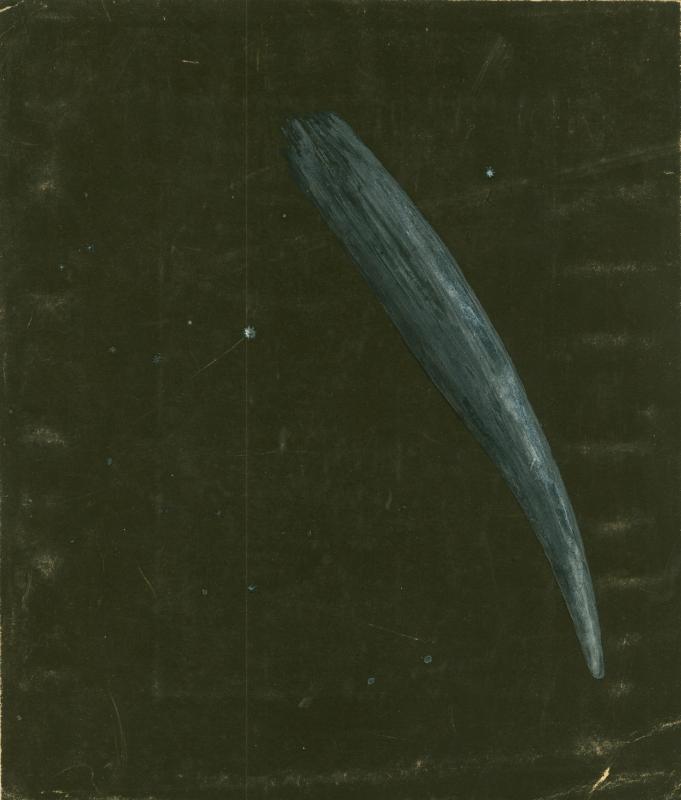R.A. Rosenfeld (RASC Archivist) and Clark Muir (KW Centre)
Unidentified comet in starfield, anon., late 19th-early 20th century. Watercolours on black paper. 6.5''x7.69''. There are no annotations on the image or the page on which it is mounted to aid in the identification of either the comet, or the artist, and no details of the instrument used (if any), or the circumstances of the observation. The image is quite competently done, and is comparable to similar Victorian and Edwardian images of comets.
The proportion of head to tail, and its general shape are reminiscent of Donati's comet (C/1858 L1, 1858 VI), yet the curve of its tail is reversed, which seems an odd graphic strategy for portraying a naked-eye comet. The curve is approximately right for the Great Comet of 1882 (C/1882 R1, 1882 II), yet their tails, particularly towards their termini, can be read as dissimilar. If one looks closely at the brightest star on the left, it appears as though there are about 5 stars nearby - if they are not smudges, or droplets of pigment. If one assumes the bright star is Regulus, the five other stars appear to represent with some verisimilitude a portion of the sickle of Leo. In this case west is pointing nearly straight up. Even Omicron Leonis is on the sketch. In mid September this orientation is about right for a predawn eastern sky. As far as we can tell the 1882 comet nucleus was located in this area. The problem is identifying a latitude in which the sky is dark enough to see these dimmer stars of Leo, and in which the comet appears above the horizon. This most likely option places the observer in the tropics. The bright star on the other side of the comet could be Alphard in Hydra, although the position is not drawn with comparable accuracy.
In his MS The "Southern Cross" An Astronomers notes of a voyage to Australia 1882-3, the professional observer Charles Grover (1842-1921) describes and draws a very slight curve on the tail of his renderings of the Great Comet of 1882; see in particular the drawings on pp. 12 and 20 of the digital edition (the comet is discussed at pp. 8-20). The comet in his drawings is approximately parallel to the ecliptic.
Comparing the RASC comet painting to Grover's drawing on p. 12, the angles relative to the horizon are different. This can most easily be explained by a difference in latitude. The images would have to have been done on different dates, perhaps 4 or 5 days apart. The comet has moved a fair bit between the RASC's and Grover's image on p. 12.
Another feature singled out by Grover does seem to be detectable in the RASC painting, although not as vividly as seen by him:
"... a clear dark cone shaped shadow or channel is visible down the middle of the tail and can be traced with a good binocular glass down to a fine line nearly to the nucleus" (p. 12 - also described in Barbara Slater, The Astronomer of Rousdon: Charles Grover 1842-1921 [Bury St. Edmunds-Carleton Rode: Steam Mill Publishing and Courseware Publications], p. 119).
It would be interesting to know which member of the Canadian astronomical community made the image, whether it represents an actual observation made in the tropics, or whether the RASC image is an interpretation (copy) of an other observer's image or a conflation of several, a not uncommon practice of the time (there are several water-colour images done after Trouvelot and Barnard in the RASC Archives). Is it possible one of the Canadian astronomers was in communication with Charles Grover, or his patron Sir Cuthbert Peek, Bart.?
The combination of grey tones with a bluish cast, together with the white highlights in the RASC painting is reasonably effective. No trace of underdrawing is discernible. Lit.: Grover 1883; Grover 1901; Olson 1985; Olson and Pasachoff 1998; Slater 2005.

